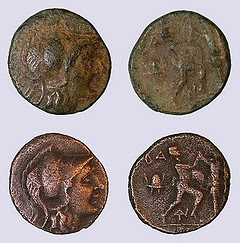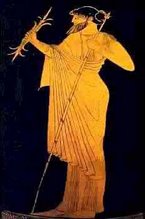
I stumbled across the following article about Princeton's ancient coin collection and found it to be fascinating. I give full credit for the article to the Associated Press and to the writer, Chris Newmarker. I hope you enjoy as much I did.
Princeton coins are gateway to history
CHRIS NEWMARKER
Associated Press
PRINCETON, N.J. - Alan Stahl has a lot of change on his hands - and not the kind you can cash in at any bank. The curator of Princeton University's numismatic collection is in charge of protecting and displaying tens of thousands of coins, tokens, medals, and pieces of paper money.
"The funny thing is, I've never owned a personal coin collection," said Stahl, 60.
The 150-year-old collection started as an assemblage of plaster casts of ancient Greek and Roman coins. Stahl estimates it now contains about 80,000 items.
New acquisitions in the past year have made the collection even more diverse: a donation of 2,000 ancient Chinese coins, and the purchase of more than 800 medieval Greek coins, bought for hundreds of thousands of dollars.
About a dozen university students each spend a few hours a week cataloging the coins. So far, the collection's online system has more than 3,000 coins listed, about 1,000 coins entered in each year.
"At this rate, we'll be done in 50 years," Stahl said.
For the students, cataloging the coins is an education in itself. As a junior majoring in classics, 21-year-old Joe Codega has read a great deal about the ancient Romans.
But he felt a greater connection with the subject he loves last week as he held a brass coin with the image of the big-chinned Roman Emperor Nero on the front. The back showed Rome's temple of Janus with its doors closed - a symbol that the empire was at peace.
"It's neat to be able to hold something that an ancient person held," Codega said.
Some of the collection's coins are on display at Princeton's Firestone Library, where the collection is housed.
Any member of the public can also ask to see a tray with some coins, though Stahl will keep close watch to make sure coins don't go missing. Stahl still cringes when he recalls a theft at the American Numismatic Society when he was there in the late 1980s.
"I'm pleased to say I wasn't the person handing him the trays," Stahl said.
Half of the collection, about 30,000 coins, comes from Princeton University archaeological work in Antioch, in what is now Turkey, during the late 1930s.
The dig turned up a trove of ancient Greek, Roman, Byzantine and Islamic coins. Stahl still handles envelopes with the handwriting of the lead archeologist's wife, who catalogued the money.
"Sometimes I can see where she scraped just a little to bring up a mark for identification. We wouldn't do that today, but I can see her rationale. I do feel a certain kinship to her," Stahl said.
The collection includes Byzantine coins that are bent, almost in cup shapes. Some of the ancient Chinese coins are shaped like knives and keys.
But for the most part, the coins are round and flat - a feature Stahl guesses might be due to functionality.
"The knife coins would sure punch a hole in your pocket or purse. I guess a square coin would be bad," Stahl said.
Stahl first became interested in coins in the early 1970s while studying for his doctoral degree in medieval history at the University of Pennsylvania.
Kingdoms and empires, Stahl said, usually have rulers on the front of their coins, though the Byzantine Empire also used Jesus. Republics in history have avoided living people, and instead concentrated on symbols of what is valued by the state.
Particularly in the past, most average people didn't see their country's capital and its public buildings, or the nation's important documents. But they did see coins.
"Virtually every person is exposed to the coinage of that country," Stahl said.
Again, I hope you enjoyed the article. Thank you for reading and God Bless.. Jerry..









